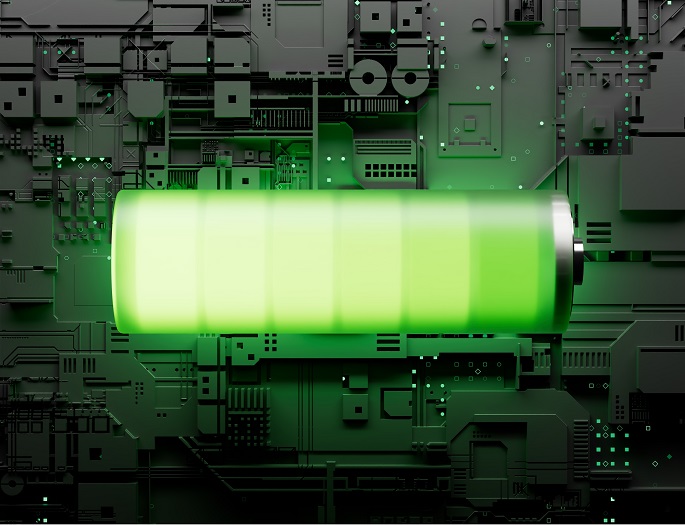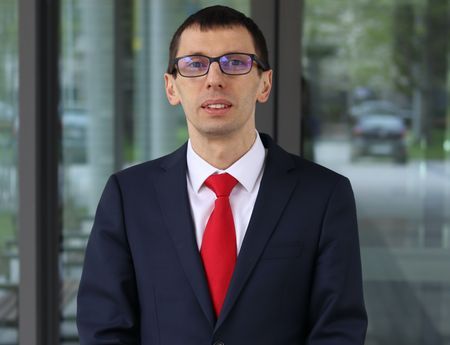
Researchers at the Jagiellonian University have developed a new method of storing energy which will make it possible to become independent from foreign suppliers of graphite and expensive metals needed for batteries. The solutions proposed by JU researchers meet the requirements of green energy, some of them leave no carbon footprint, and the prototype batteries have similar or even better parameters than the ones currently produced.
A research team led by Prof. Marcin Molenda, head of the Technology of Materials and Nanomaterials Research Group at the JU Faculty of Chemistry, has developed solutions that show promise in regard to new technologies of energy storage and battery production, including devices used in electric cars. Since its inception, Prof. Molenda’s team had a holistic approach to working on improvements in the area of green consumer energy. This approach involves developing new methods of producing new types of energy storages as well as studying a number of parameters related to operating loads and searching for ways of safe disposal or reuse of materials.
The results of years-long research prove that it’s possible to introduce systemic changes in the process of production of high-voltage batteries. According to Prof. Molenda, by basing the process on principles espoused by green chemistry (also called sustainable chemistry), we could mass-produce more sustainable batteries and become independent from rare, expensive and polluting resources which are currently used in the production of energy storage devices, such as metals or graphite.
Starch-based carbon aerogels (CAG) and cobalt-free low-nickel cathodes (LKMNO)
CAG is one of the technologies developed by Prof. Molenda’s team. It allows to create anodes based on carbogel made from starches, which makes them sustainably-sourced. The starches are extracted from plants such as rice, potatoes or corn and gelatinised using water, then undergo the process of controlled pyrolysis. After that, they can be used as a substitute for natural and artificial graphite without lowering the batteries’ capacity. Such anodes generate no carbon footprint and can be produced from products with secure supply chains. CAG anodes can be used in conjunction with any cutting edge cathodes in lithium-ion cells. Tests have shown that CAG anodes also have a high durability (more than 1500 discharge/charge cycles).
 ‘The developed carbogel can be used to produce green lithium-ion cells with a reduced carbon footprint. It also has the benefit of being made of widely available materials and, consequently, independence from foreign suppliers of graphite. CAG exhibits similar energy density to batteries with natural graphite, but it has the advantage allowing for a higher power output’, explained Prof. Marcin Molenda.
‘The developed carbogel can be used to produce green lithium-ion cells with a reduced carbon footprint. It also has the benefit of being made of widely available materials and, consequently, independence from foreign suppliers of graphite. CAG exhibits similar energy density to batteries with natural graphite, but it has the advantage allowing for a higher power output’, explained Prof. Marcin Molenda.
LKMNO is technology which enables the production of cobalt-free high-voltage cathodes with five times less nickel and two times less lithium (compared to NMC materials). This type of cathode is also produced according to the principles of green chemistry. The production method is water-based, using condensation drying and calcination in moderate temperatures, which means it requires a relatively low amount of energy. What’s important, the cathode is made via one-pot synthesis, meaning it doesn’t generate any solid or liquid waste, while all gases are processed into carbon dioxide, nitrogen and steam. The LKMNO cathode can be easily paired with all kinds of anodes (including CAG) and electrolytes used in modern lithium-ion cells. LKMNO cathodes can also be used to produce dedicated high power and high capacity cells, such as those used in battery electric vehicles.
‘The cost of producing a LKMNO cathode is twice as low as producing a cutting edge NMC cathode, which contains nickel, manganese and cobalt. Additionally, our cathode uses two times less lithium than NMC cathodes while making full use of it. Other modern lithium-ion cells only make use of about 50% of their lithium’s potential output, and lithium is quite expensive. So that’s purely a waste. In contrast, lithium in LKMNO cathodes is 100% efficient’, said Prof. Marcin Molenda.
Thin carbon layer prevents batteries from combustion
Prof. Marcin Molenda also points to yet another of his technologies: the carbon conductive layer (CCL), which offers a chance to develop a whole new generation of batteries. CCL is a nanotechnological method of covering the active materials in energy storage devices (both cathodic and anodic) with a layer of carbon that is just a few nanometres thick. The JU research team knows how to determine the thickness of such a layer in the earliest stages of production, making it possible to precisely plan the battery’s purpose by fine-tuning parameters like discharge time and load limit. The layer is effective enough that it becomes unnecessary to use any additional carbon material, so the battery can have a higher energy density. But that’s not the main advantage of this technology: it's the very high safety level, which essentially means these batteries can’t spontaneously ignite.
‘Carbon material is added to batteries to ensure sufficient conductivity. Previous technologies, however, don’t allow for precise arrangement of carbon particles between those of active materials. As a result, batteries contain a large amount of carbon, which leads to lower energy density. Because batteries are subject to changes in temperature, there is an increased risk of spontaneous combustion when the carbon material is not evenly distributed. CCL eliminates that risk, because the particles of active materials are tightly covered, making them effectively separated from one another. In a battery like that, even if there is a short circuit, the process of discharge will happen much more slowly, negating the risk of ignition. CCL covers the active material thoroughly even if it’s structure is porous, and stays in position during even the most significant swings in temperature’, said Prof. Marcin Molenda.
The urgent issue of resource availability
Market predictions clearly show that in the next seven years global demand for batteries and other energy storages will increase by several times or more. This is caused chiefly by new environmental regulations. The expansion of the battery market is also driven by the increasing numbers of electric cars as well as the rapidly growing network of local solar energy prosumers. Due to issues with transferring energy from prosumers to electrical networks and settling payments, more and more local energy storages are needed to meet the requirements of households and workplaces.
 The scale of growth of energy storage market is well illustrated by numbers. For instance, in 2018, the demand for energy from lithium-ion batteries was estimated at 0.184 TWh per year. The latest predictions approximate that number to rise to 4.7 TWh by 2023, meaning it will increase 25 times in the span of 12 years. According to the Polish Alternative Fuels Association, by 2023 there will be 10 times more electric cars in Poland alone, despite the fact that the Polish market grows at a slower pace than the EU average. BloombergNEF analysist indicate that by 2030, the global market for energy storage will increase by 15 times. Somebody will have to produce such a great number of batteries, emitting a lot of harmful substances into the environment and using a lot of rare and, consequently, expensive resources, such as cobalt, nickel and lithium, but also graphite needed for anodes.
The scale of growth of energy storage market is well illustrated by numbers. For instance, in 2018, the demand for energy from lithium-ion batteries was estimated at 0.184 TWh per year. The latest predictions approximate that number to rise to 4.7 TWh by 2023, meaning it will increase 25 times in the span of 12 years. According to the Polish Alternative Fuels Association, by 2023 there will be 10 times more electric cars in Poland alone, despite the fact that the Polish market grows at a slower pace than the EU average. BloombergNEF analysist indicate that by 2030, the global market for energy storage will increase by 15 times. Somebody will have to produce such a great number of batteries, emitting a lot of harmful substances into the environment and using a lot of rare and, consequently, expensive resources, such as cobalt, nickel and lithium, but also graphite needed for anodes.
‘In the face of such great and rapid development of this market, the world must already deal with two difficult challenges. The first one is the production of batteries according to rules and regulations that enforce the use of methods that are not detrimental to the planet. The second is the limited availability of resources: rare and expensive materials as well as graphite. These elements can be mined in only a few places, and in amounts that are insufficient for the global demand. As a result, the energy storage industry is increasingly dependent on countries with access to these resources. Growing demand also leads to a increase in prices, which further aggravates economic problems. Not changing the status quo will mean a drastic increase in energy costs and a more polluted environment’, stressed Prof. Marcin Molenda.
Sooner or later, it’ll become a necessity for the energy storage industry to make use of sustainable chemistry. In the near future, it’ll become essential to introduce alternative methods of battery production, eliminating rare, expensive and harmful metals. The problem is serious enough that battery efficiency becomes a secondary issue, with primary focus on the cheapness of production, adequate durability and capacity, safety and ease of mass production based on accessible resources and secure supply chains.
Ready for implementation
Inventions developed by the Jagiellonian University Technology of Materials and Nanomaterials Research Group are patent protected. The Centre for Technology Transfer CITTRU works on finding a way to implement their solutions into production processes. For that, they need to collaborate with an investor or energy storage producer who will be able to build a pilot plant and standardise production on an industrial scale. For the purpose of commercialising this technology, its inventor established a spin-off company (UJ MarCelLi Adv Tech LLC) and signed a conditional licence agreement. JU researchers are ready to work with third parties at every stage of increasing the technological readiness level (TRI), from the acquisition of resources to recycling.
‘These battery technologies have an extreme potential for implementation. It’s important that they are introduced by an entity with appropriate experience and scope of activity. One of the options we’re considering is working with an existing company seeking to improve its products while simultaneously lowering costs. We can also see a way in which a producer decides to introduce a completely new generation of batteries that will be safer, greener, cheaper and based on secure supply chains. We have several advantages that will make us strong competitors in the field’, said Dr Gabriela Konopka-Cupiał, Director of the Centre for Technology Transfer CITTRU.
Original text: www.nauka.uj.edu.pl





